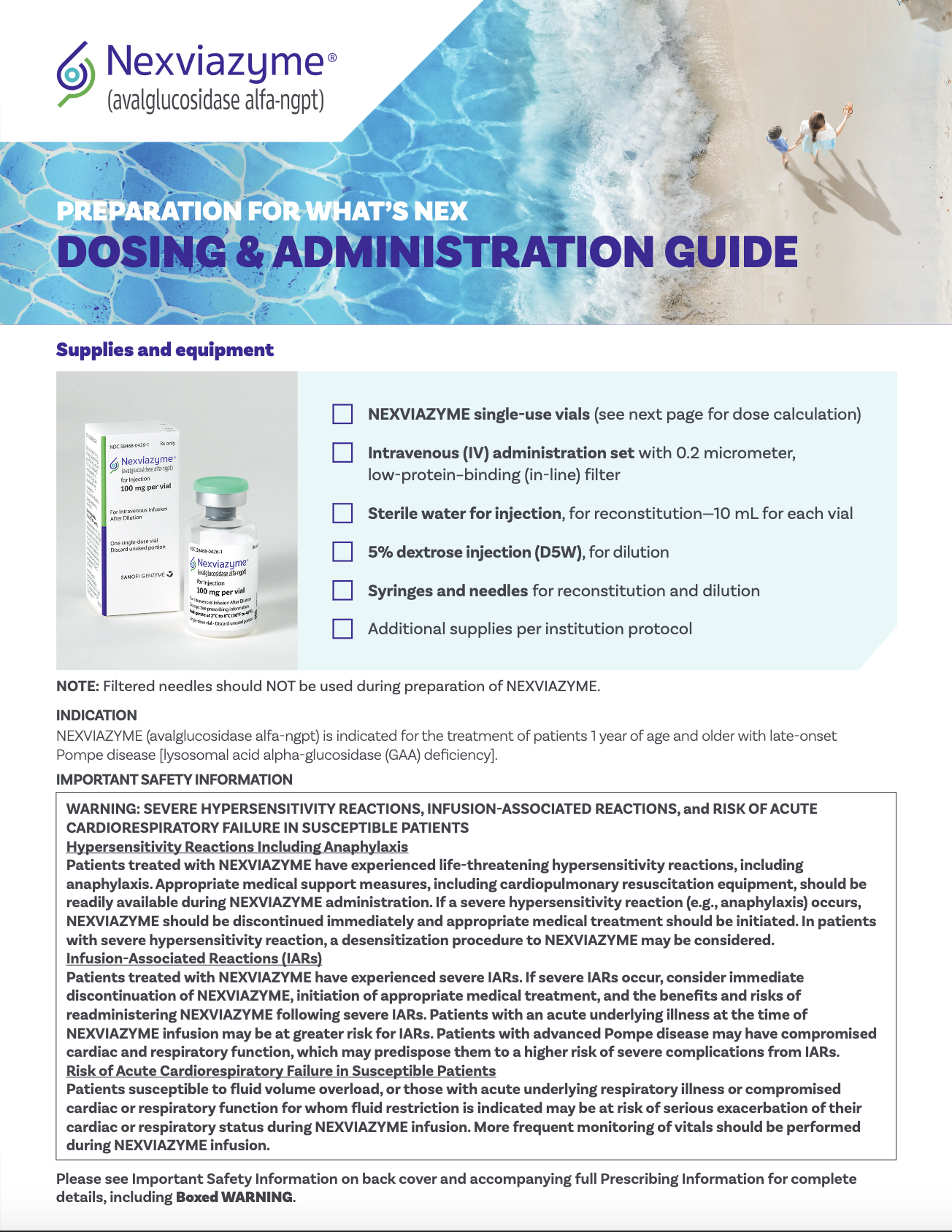NEXVIAZYME: Given as a monotherapy without fasting, stabilizers, or a washout period1,2,*
Prior to NEXVIAZYME administration, consider pretreating with antihistamines, antipyretics, and/or corticosteroids. NEXVIAZYME must be reconstituted and diluted prior to use.
*Not including premedication or pretreatment.
The recommended biweekly dosage of NEXVIAZYME1
| For patients weighing <30 kg |
|
40 mg/kg (of actual body weight) every 2 weeks |
| For patients weighing ≥30 kg |
| 20 mg/kg (of actual body weight) every 2 weeks |
Administration modifications due to hypersensitivity reactions and/or IARs1
Administration modifications with NEXVIAZYME may be necessary due to severe hypersensitivity reactions (including anaphylaxis) or a severe IAR. Please consult the full Prescribing Information for instructions on appropriate administration modifications before beginning administration.
Switching to NEXVIAZYME can be a simple process1,2

The majority of ERT-treated patients with LOPD have switched to NEXVIAZYME2,*
- Patients who switch can begin receiving treatment without washout period between the final alglucosidase alfa dose and the first NEXVIAZYME dose1
- Patients may also be able to keep their same dosing schedule and their same infusion center2
*Prescription data as of February 2024.

The Dosing Guide has important information for the dosing and administration of NEXVIAZYME.
The initial recommended infusion rate is 1 mg/kg/hour1
Gradually increase the infusion rate every 30 minutes if there are no signs of infusion-associated reactions (IARs).
Projected intravenous infusion volume for NEXVIAZYME administration according to patient’s weight
|
4-STEP PROCESS |
|||||||
|
PATIENT WEIGHT RANGE (kg) |
TOTAL INFUSION VOLUME (mL) |
RECOMMENDED DOSE (mg/kg) |
Step 1 1 mg/kg/hour |
Step 2 3 mg/kg/hour |
Step 3 5 mg/kg/hour |
Step 4 7 mg/kg/hour |
APPROXIMATE TOTAL INFUSION DURATION |
|
INFUSION RATE (mL/hour) |
|||||||
|
5 to 9.9 |
100 |
40 |
3 |
8 |
13 |
18 |
7 hours |
|
10 to 19.9 |
200 |
5 |
15 |
25 |
35 |
||
|
20 to 29.9 |
300 |
8 |
23 |
38 |
53 |
||
|
30 to 34.9 |
200 |
20 |
10 |
30 |
50 |
70 |
4-5 hours |
|
35 to 49.9 |
250 |
13 |
38 |
63 |
88 |
||
|
50 to 59.9 |
300 |
15 |
45 |
75 |
105 |
||
|
60 to 99.9 |
500 |
25 |
75 |
125 |
175 |
||
|
100 to 119.9 |
600 |
30 |
90 |
150 |
210 |
||
|
120 to 140 |
700 |
35 |
105 |
175 |
245 |
||
|
5-STEP PROCESS* |
||||||||
| PATIENT WEIGHT RANGE (kg) | TOTAL INFUSION VOLUME (mL) | RECOMMENDED DOSE (mg/kg) |
Step 1 1 mg/kg/ hour |
Step 2 3 mg/kg/ hour |
Step 3 6 mg/kg/ hour |
Step 4 8 mg/kg/ hour |
Step 5 10 mg/kg/ hour |
APPROXIMATE TOTAL INFUSION DURATION |
| INFUSION RATE (mL/hour) | ||||||||
|
5 to 9.9 |
100 |
40 |
3 |
8 |
15 |
20 |
25 |
5 hours |
|
10 to 19.9 |
200 |
5 |
15 |
30 |
40 |
50 |
||
|
20 to 29.9 |
300 |
8 |
23 |
45 |
60 |
75 |
||
Step 1 indicates the starting infusion rate. If there are no signs of IARs, gradually increase the infusion rate every 30 minutes to the subsequent step.
*The 5-step process should be used only for subsequent infusions.
|
WARNING: SEVERE HYPERSENSITIVITY REACTIONS, INFUSION-ASSOCIATED REACTIONS, and RISK OF ACUTE CARDIORESPIRATORY FAILURE IN SUSCEPTIBLE PATIENTS Hypersensitivity Reactions including Anaphylaxis Patients treated with NEXVIAZYME have experienced life-threatening hypersensitivity reactions, including anaphylaxis. Appropriate medical support measures, including cardiopulmonary resuscitation equipment, should be readily available during NEXVIAZYME administration. If a severe hypersensitivity reaction (e.g., anaphylaxis) occurs, NEXVIAZYME should be discontinued immediately and appropriate medical treatment should be initiated. In patients with severe hypersensitivity reaction, a desensitization procedure to NEXVIAZYME may be considered. Infusion-Associated Reactions (IARs) Patients treated with NEXVIAZYME have experienced severe IARs. If severe IARs occur, consider immediate discontinuation of NEXVIAZYME, initiation of appropriate medical treatment, and the benefits and risks of readministering NEXVIAZYME following severe IARs. Patients with an acute underlying illness at the time of NEXVIAZYME infusion may be at greater risk for IARs. Patients with advanced Pompe disease may have compromised cardiac and respiratory function, which may predispose them to a higher risk of severe complications from IARs. Risk of Acute Cardiorespiratory Failure in Susceptible Patients Patients susceptible to fluid volume overload, or those with acute underlying respiratory illness or compromised cardiac or respiratory function for whom fluid restriction is indicated may be at risk of serious exacerbation of their cardiac or respiratory status during NEXVIAZYME infusion. More frequent monitoring of vitals should be performed during NEXVIAZYME infusion. |
WARNINGS AND PRECAUTIONS
Hypersensitivity Reactions Including Anaphylaxis: See Boxed WARNING. Prior to NEXVIAZYME administration, consider pretreating with antihistamines, antipyretics, and/or corticosteroids. The risks and benefits of readministering NEXVIAZYME following severe hypersensitivity reaction (including anaphylaxis) should be considered. If a mild or moderate hypersensitivity reaction occurs, the infusion rate may be slowed or temporarily stopped.
Infusion-Associated Reactions: See Boxed WARNING. IARs may still occur in patients after receiving pretreatment. If mild or moderate IARs occur regardless of pretreatment, decreasing the infusion rate or temporarily stopping the infusion may ameliorate the symptoms.
Risk of Acute Cardiorespiratory Failure in Susceptible Patients: See Boxed WARNING.
ADVERSE REACTIONS
The most common adverse reactions (>5%) were headache, fatigue, diarrhea, nausea, arthralgia, dizziness, myalgia, pruritus, vomiting, dyspnea, erythema, paresthesia and urticaria.
INDICATION
NEXVIAZYME (avalglucosidase alfa-ngpt) is indicated for the treatment of patients 1 year of age and older with late-onset Pompe disease [lysosomal acid alpha-glucosidase (GAA) deficiency].
Please see full Prescribing Information for complete details, including Boxed WARNING.
References: 1. NEXVIAZYME (avalglucosidase alfa-ngpt) [prescribing information]. Genzyme Corporation, Cambridge, MA. 2. Data on file. Genzyme Corporation.
|
WARNING: SEVERE HYPERSENSITIVITY REACTIONS, INFUSION-ASSOCIATED REACTIONS, and RISK OF ACUTE CARDIORESPIRATORY FAILURE IN SUSCEPTIBLE PATIENTS Hypersensitivity Reactions including Anaphylaxis Patients treated with NEXVIAZYME have experienced life-threatening hypersensitivity reactions, including anaphylaxis. Appropriate medical support measures, including cardiopulmonary resuscitation equipment, should be readily available during NEXVIAZYME administration. If a severe hypersensitivity reaction (e.g., anaphylaxis) occurs, NEXVIAZYME should be discontinued immediately and appropriate medical treatment should be initiated. In patients with severe hypersensitivity reaction, a desensitization procedure to NEXVIAZYME may be considered. Infusion-Associated Reactions (IARs) Patients treated with NEXVIAZYME have experienced severe IARs. If severe IARs occur, consider immediate discontinuation of NEXVIAZYME, initiation of appropriate medical treatment, and the benefits and risks of readministering NEXVIAZYME following severe IARs. Patients with an acute underlying illness at the time of NEXVIAZYME infusion may be at greater risk for IARs. Patients with advanced Pompe disease may have compromised cardiac and respiratory function, which may predispose them to a higher risk of severe complications from IARs. Risk of Acute Cardiorespiratory Failure in Susceptible Patients Patients susceptible to fluid volume overload, or those with acute underlying respiratory illness or compromised cardiac or respiratory function for whom fluid restriction is indicated may be at risk of serious exacerbation of their cardiac or respiratory status during NEXVIAZYME infusion. More frequent monitoring of vitals should be performed during NEXVIAZYME infusion. |
WARNINGS AND PRECAUTIONS
Hypersensitivity Reactions Including Anaphylaxis: See Boxed WARNING. Prior to NEXVIAZYME administration, consider pretreating with antihistamines, antipyretics, and/or corticosteroids. The risks and benefits of readministering NEXVIAZYME following severe hypersensitivity reaction (including anaphylaxis) should be considered. If a mild or moderate hypersensitivity reaction occurs, the infusion rate may be slowed or temporarily stopped.
Infusion-Associated Reactions: See Boxed WARNING. IARs may still occur in patients after receiving pretreatment. If mild or moderate IARs occur regardless of pretreatment, decreasing the infusion rate or temporarily stopping the infusion may ameliorate the symptoms.
Risk of Acute Cardiorespiratory Failure in Susceptible Patients: See Boxed WARNING.
ADVERSE REACTIONS
The most common adverse reactions (>5%) were headache, fatigue, diarrhea, nausea, arthralgia, dizziness, myalgia, pruritus, vomiting, dyspnea, erythema, paresthesia and urticaria.
INDICATION
NEXVIAZYME (avalglucosidase alfa-ngpt) is indicated for the treatment of patients 1 year of age and older with late-onset Pompe disease [lysosomal acid alpha-glucosidase (GAA) deficiency].
Please see full Prescribing Information for complete details, including Boxed WARNING.
References: 1. NEXVIAZYME (avalglucosidase alfa-ngpt) [prescribing information]. Genzyme Corporation, Cambridge, MA. 2. Data on file. Genzyme Corporation.

